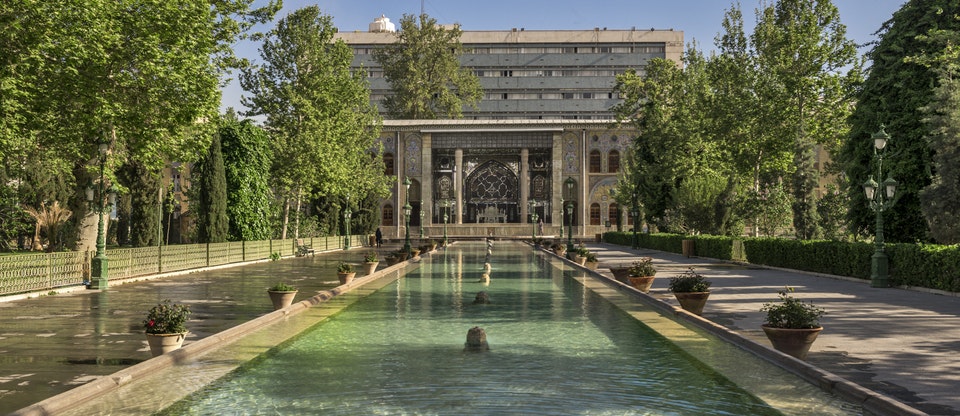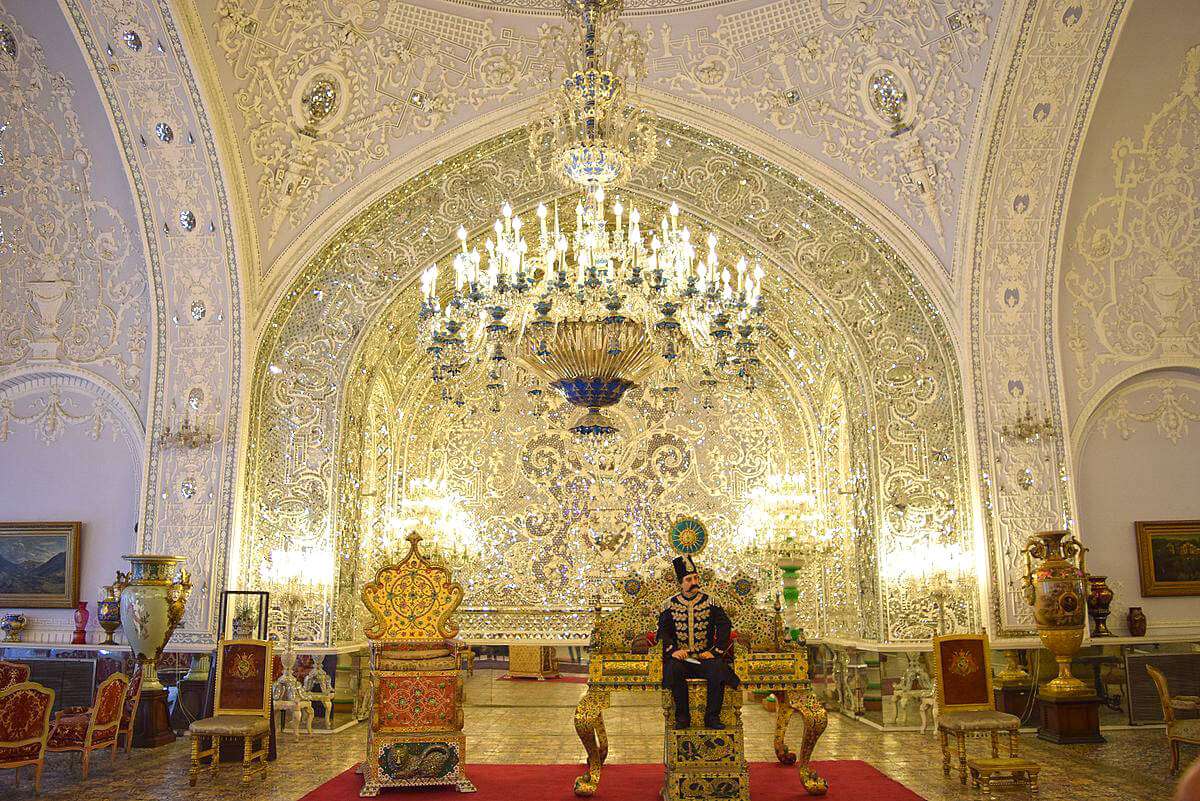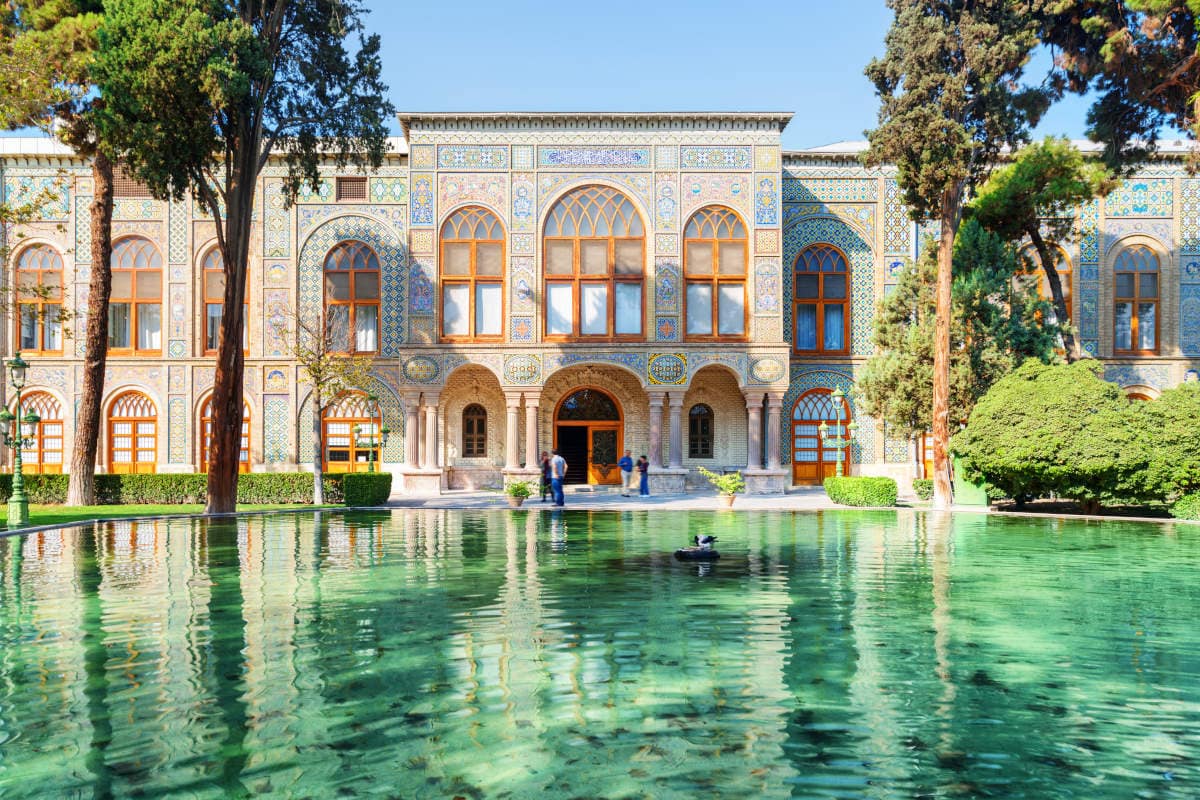Golestan Palace, known in Persian as Kakh-e Golestan, is one of the oldest buildings in Tehran. This royal Qajar settlement consists of an enchanting garden and a group of well-preserved decorated buildings. This Unesco Heritage site showcases the development of art and architecture of Iran and the influence of western art on them.
You will gain more insight about Golestan Palace by reading the following about this significant highlight of Tehran.
Golestan Palace History
Golestan Palace has been listed as World Heritage Site as an important example of Iranian contemporary art and architecture. The initial core of the Golestan Palace started in Safavid era. Shah Tahmasb, I planed the development of the city of Tehran in the 16th century. He ordered to build a defensive wall around the city and accordingly Arg-e Tehran (Citadel of Tehran) was built. Arg-e Tehran obtained its importance in Aqa Mohammad Khan’s era, the founder of Qajarid dynasty who chose Tehran as the ruling capital for Qajar dynasty in 1779. Accordingly, Golestan palace became the seat of the government of the Qajar family.
From the seat of power to the museum of art and architecture in Iran
The idea of the current palace was brought up by Naser al-Din Shah (1848-96) who was inspired by the European palaces due to his numerous trips to European countries. The complex has gone through several construction and deconstruction phases during the history. To bring a few examples of these changes, we should mention that Divan Khaneh and its adjoining garden were added in Zand era (1759 -1766). The majority of the Golestan sites were built in Qajar era (1789-1925) of which some buildings, such as Tekieh Dowlat, Khorshid Building and Sarvestan Buildong are destroyed. Some renovations and constructions were also done in Pahlavi era (1925-1979) and the function of some sites was changes.

Golestan Palace Sites
Golestan palace is the greatest achievement in Tehran 18th-19th century art. This palace represents the development of Iranian architecture and the influential role of western art on it.
Golestan Palace covers an area 53000 sq. m housing several sites such as Marble Throne Veranda ( Ayvan-e Takht-e Marmar) , Brilliant house( Talar-e Berelian ), Karimkhani Nook (Khalvat-e Karimkhani), Shams al-Emareh, Reception Hall (Talar-e Salam), Wind tower Edifice (Emarat-e Badgir), Aj house (Talar-e Aj), Container’s hall (Talar-e Zorouf), Diamond hall (Talar-e Almas ), White Palace (Khaney-e Abyaz).
As this residential and recreational palace was reconstructed several times during the history, each site represents individual characteristics. We will talk more below about the sites in Golestan Palace; so, follow us if you want to have an idea of this UNESCO Heritage Site.
Marble Throne (Takht e Marmar)
Marble throne is one of the oldest buildings in the complex dating back to the Zand era (18th century). It was built by the order of Karim Khan Zand, the founder of Zand dynasty, in 1759. Later in Qajarid era, it turned into a reception hall and it has undergone several reconstruction phases. Aqa Mohammad Khan, the founder of Qajar dynasty, ordered to bring stone plinths and doors from Vakil palace in Shiraz, the seat of the previous Zand dynasty.
Peacock Throne
The iconic feature of this part is the peacock throne giving its name to the veranda. At first the jeweled throne used to be at this hall, but, later Fath Ali shah (r. 1797–1834) ordered to build a marble throne and replace the peacock throne. The marble throne was inspired by the Solomon’s throne being carried on the shoulders of angles. It is composed of 65 pieces and the decorated by verses of a poem admiring Fath Ali Shah and describing the throne itself.
Mirror Hall (Talar e Aineh)
The mirror hall is located next to Talar-e Salam. As the name suggests, the walls and the ceiling of this hall is covered by the intricate mirrorwork.
The mirror hall has preserved its reputation due to one of the most famous paintings of Kamal al-Molk from this hall. This well-known royal painter spent 5 years portraying this hall including the picture of Naser al-din shah sitting in a corner of it and enjoying the view. You can visit this well-preserved painting in Talar-e Salam now and feel the royal spirit of the palace at its heydays. Some valuable items such as the peacock throne and Naderi throne were used to be kept in this hall which were moved to the jewelry museum for better preservation.
Diamond Hall (Talar e Almas)
Diamond hall is a Qajarid building at the southern wing of the palace constructed in Fath Ali Shah Qajar era and renovated in Naser al-din Shah Qajar era. The name diamond is designated due to the wonderful mirrorwork and mirror stalactites of the hall. This hall consists of a main hall adjoining two rooms, two storied alcove and a pool house (Howz Khane ) in the basement. Three large lattice doors (Orosi) invites the visitors to the outdoor view.

Where is Golestan Palace?
Golestan Palace is a former Iranian royal residence and center of government. It is located in the old governmental neighborhood of Tehran where many other historical landmarks are situated. You can reach this palace in Panzdah-e- Khordad street and at the northern wing of Arg square.
Golestan Palace Location
Now a national landmark, Golestan palace is located in the old neighborhood of Tehran where other highlights of the city are located at its walking distance.
How to Get to Golestan Palace?
The best way to reach Golestan Palace is by subway. You can get off the subway in Panzdah-e Khordad station. It is a 5-minute walking distance from this station to the entrance of the palace.
You can also use other public transportations such as buses. The bus terminal is located in Imam Khomeini square.
If you want to visit Golestan palace by your own car, you need to park your car in flanking streets, since private cars are not allowed at the historical district.
Public taxies are also available in every corner of the city.
When to visit Golestan Palace?
Visiting Golestan palace is an enjoyable experience in every season. In spring and summer, you can visit the palace from 9:30 AM to 6:30 PM and in autumn and winter from 9 AM to 6:30 PM. Golestan palace is open in Norouz holiday but it is closed in other national holidays.
Golestan Palace Complex entrance fee?
The entrance fee to the palace is about 4 $ for each visitor. However, the majority of the sites in the complex need separate entrance fees. If you want to visit the whole complex you need to pay about 24 $ in total.

FAQ
Golestan Palace is situated at the area of Tehran with lots of comfortable accommodations for tourists. Hanna Boutique Hotel is one of the cozy and popular stays near the palace. If you prefer to have a luxurious experience try Ferdowsi Hotel. To budget your trip to Tehran, you can book 2-star hotels nearby such as Shahryar Hotel, Markazi Iran Hotel, Golestan Hotel. If you want to experience a traditional sprit of Iran, you can stay in Arian Boutique Hotel.
Golestan Palace is very close to the traditional restaurants in Tehran. The best options to eat are located near Grand bazaar which is in the walking distance of the palace. To try the taste of the original Iranian cuisine, you can go to Shamshiry restaurant, Sharaf El Islam, Moslem Restaurant and Khayyam restaurant.
If your time is limited and you plan to visit Golestan palace in a half day, the good news is that Golestan Palace is located at the historical district surrounded by the significant Tehran attractions. National museum of Iran, Grand Bazaar, National Jewelry museum, Abgineh Museum of Tehran, Malek National museum and Shah mosques of Tehran are some of the highlights you can visit after visiting Golestan Palace.
Golestan palace is about 442 years old. The primary foundation of Golestan Palace was established in 16th century. The current complex, however, is the remnant of the constructions carried out between 18th to 20th century.
Golestan Palace is located in the capital city of Iran, Tehran. It is located in Panzdah-e- Khordad street and at the northern wing of Arg square.
The primary foundation of Golestan Palace was established in 16th century. The current complex, however, was built between 18th to 20th century.
The idea of building Golestan Palace was brought up by Naser al-din Shah, the Qajarid king. Most parts of the palace such as Shams-ol Emare was designed and commissioned by Moayer ol Mamalek . The construction of the palace was mainly carried out by the well-known Qajarid architect, Mohammad Ali Kashi.
The entrance fee to Golestan Palace depends on the number of the sites you are going to visit:
4 $ for the entrance
24 $ for the whole complex
Here are the opening and closing hours:
Spring and summer: Open from 9:30 AM to 6:30 PM
Autumn and winter: Open from 9 AM to 6:30 PM.
You can get off the subway in Panzdah-e Khordad station.
To reach the Golestan Palace by bus, you can use the lines passing over Khayyam street and stops at Galoubandak station.



Comment (0)